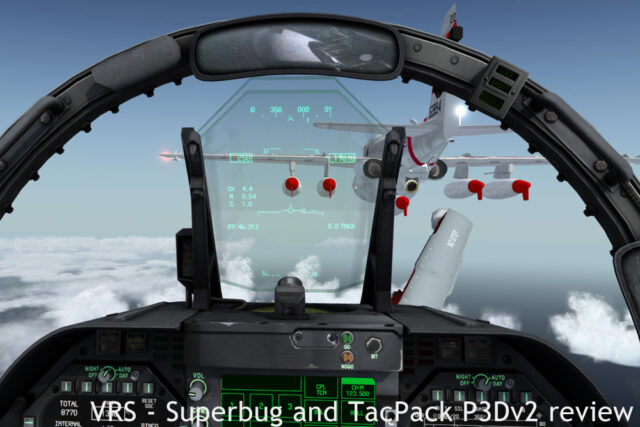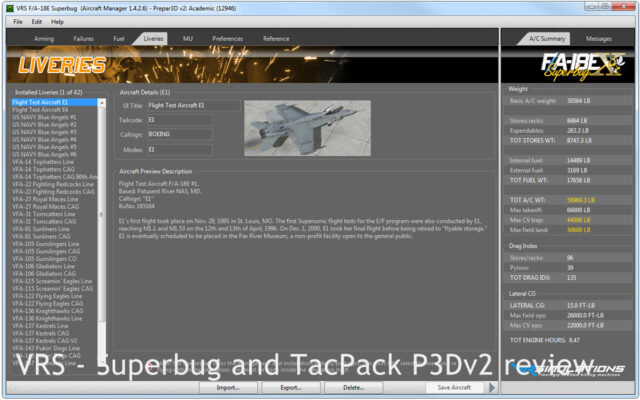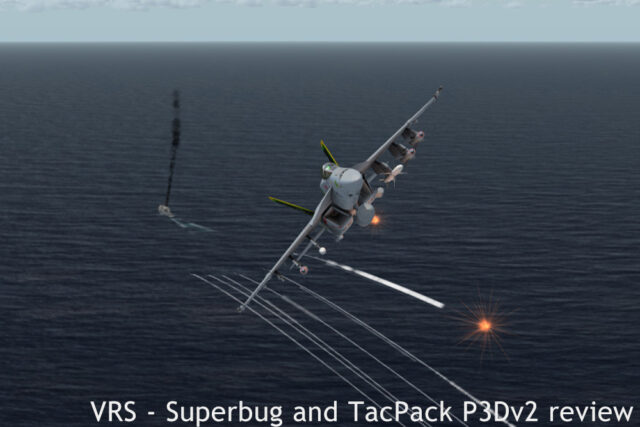 For the last couple of years, anybody interested in military aviation in FSX hasn’t been able to get around Vertical Reality Simulations’ F/A-18E Superbug for its attention to detail, or their TacPack module for how it brings weapons to a sim that wasn’t designed to handle them. A couple of months ago, they released both these products for Lockheed-Martin’s Prepar3D V2 Academic as well. And while the functionality is basically the same as for the FSX versions, I think these products are worth another look in this new environment. So let’s see how VRS did this time, shall we?
For the last couple of years, anybody interested in military aviation in FSX hasn’t been able to get around Vertical Reality Simulations’ F/A-18E Superbug for its attention to detail, or their TacPack module for how it brings weapons to a sim that wasn’t designed to handle them. A couple of months ago, they released both these products for Lockheed-Martin’s Prepar3D V2 Academic as well. And while the functionality is basically the same as for the FSX versions, I think these products are worth another look in this new environment. So let’s see how VRS did this time, shall we?
VRS’s TacPack wasn’t the first weapons simulation package in FSX. However, it combines a lot of features that, in themselves or as part of the whole, set it apart from the competition. Some of its core features: a whole lot of weapons, as realistically simulated as possible, that actually destroy AI traffic; single and multiplayer support, combined with anti-cheating measures for balanced multiplayer fighting; deployable AI-traffic, from aircraft carriers and airborne tankers to SAM-sites and target drones. And last but certainly not least: an SDK (software development kit) and support for 3rd party developers who want to integrated TacPack functionality in their own releases.
The Boeing F/A-18E Super Hornet, also called the Superbug, is so far the only aircraft released by VRS. Their first release was the Superbug for FS9 (FS2004), being a game changer even on that well-trodden platform. In 2010, the Superbug was released for FSX. It featured unrivalled system fidelity for a military jet in FSX, including fly-by-wire simulation and releasable weapons. However, it took the release of the TacPack for these weapons to actually have an impact on the virtual world inside your simulator. With this release, the Superbug line-up split into 2 parts. First the standalone Superbug that doesn’t require the TacPack but also doesn’t use its features. This version hasn’t been developed much further after the TacPack release. The second version of the Superbug available is one that closely integrates with the TacPack. Indeed, the TacPack is required, otherwise this version of the Superbug will simply not run. This version has also seen major refinements and improvements over the (already great) standalone version. For Prepar3D v2, only the TacPack integrated Superbug is available. So, in effect, you can buy (and use) the TacPack without the VRS F/A-18E, but you can’t use the F/A-18E without the TacPack in P3D2.
As for the real F/A-18E, it started out as a McDonnel Douglas proposal for a larger version of the legacy F/A-18C Hornet in the 1980’s. Called the Hornet 2000 at that time, a study was officially launched in 1988, followed by a first order by the US Navy in 1992. The Super Hornet first took to the skies in November 1995, and underwent flight testing on through 1999. Boeing, having merged with McDonnel Douglas in August 1997, continued the Super Hornet program, and the aircraft went into full-rate production a month later.
The F/A-18E and F, the single and dual seat version respectively, were designed as an evolutionary development of the F/A-18C and D models. But in the end, the type is for the better part a new aircraft. It retains the general layout as its older sibling, but is approximately 20% larger and the 2 types have very few parts in common. The initial Super Hornet models shared most of their avionics systems and software with the Legacy Hornets, but continued improvements have significantly reduced commonality here as well.
VRS F/A-18E Superbug
Of course, opinions are subjective, and different people have different views. However, in my opinion, the VRS Superbug is one of, if not the best military aircraft available for the FSX platform. So having it available in Lockheed-Martin’s Prepar3D 2.5 is something I like very much. So much so, that I got in touch with the good people at VRS and requested to do a review about it. Let me tell you about it here.
Visuals
As usual, there’s no real quantifiable difference in the visual models of the Superbug between FSX and P3D2. However, it does profit by the improvements made in the visual engine of Prepar3D. Especially lighting and shadows are rendered better on the newer platform. Apart from that, you get the same excellent visual quality the F/A-18E already brought to FSX. A very detailed and accurate model, with very good textures in a whole bunch of different liveries. I could call attention to certain areas of the model here, and there certainly are areas where the attention to detail stands out. But in fact, the entire Superbug just looks good. If there are areas that stand out due to the amount of fine details, it’s because there are fine details there on the real aircraft as well. Whether you look at the VRS Superbug on the ground, landed on a carrier or in flight, or you look at it empty or fully laden with weapons, the overall picture just hits the right spot.
Moving inside, the virtual cockpit is also worth talking about. The entire virtual cockpit is very nicely detailed, both in the 3D modelling and the textures covering that model. From the centre panel, over the side consoles down to even the ejection seat and harness, everything is very finely detailed. Something I like a lot, is that it’s not just a pristinely represented aircraft. Rather, it’s used. There are some subtle scratches, some chipped paint, a bit of dirt… In all, a very nice cockpit that’s a pleasure to fly from.
Systems
Even though the Superbug is an all-round outstanding product, the systems simulation is probably the most detailed aspect. To be honest, this is not a full-blown ‘let’s-simulate-everything’ product. For example, the INS (Inertial Navigation System) is nothing more than a placeholder. ACLS (Automated Carrier Landing System) isn’t there either, and neither are some of the more exotic features of the fly-by-wire system. (Note that all features I just mentioned are to be a part of the ‘Pro’-version of the Superbug VRS are said to be working on.)
The ‘this-is-not-covered’ part out of the way, there are a lot of things that are covered. For example, there is a working autopilot system, as well as a realistic (realistically simple) auto throttle system. A pretty decent navigational system, and an outstanding HSI with moving map capability.
The main cockpit items used to interface with the systems are an HUD (head-up display), an UFCD (Up-Front Control Display), a MPCD (Multi Purpose Color Display) and 2 DDI’s (Digital Display Indicator).
All of these are very well represented, both visually and functionally. The HUD’s function is pretty self-explanatory. The UFCD is primarily (but not exclusively) used to interface with the radios and autopilot systems. The MPCD is limited to the HSI and moving map functions in the VRS Superbug, but does those very well. But where the virtual pilot will spend most of his ‘heads-down’ time, is with the 2 DDI’s. The amount and depth of functions these 2 displays cover is staggering. It already caused rave reviews when the first versions of the Superbug were released 5 years ago, and it has only gotten better. A lot better. From simple things like an ADI and a fuel page, over BIT (built-in test) pages and an electronic warfare system, down to detailed weapons pages and a working radar, with air, ground and sea modes. It’s just impossible to describe all possibilities. And I’ll be the first to admit, I don’t know all possibilities myself.

The big thing to remember here, is that a lot of stuff is covered. Especially on the tactical side of things. Stuff that actually allows you to use a fighter aircraft for what it’s meant to be used: deliver weapons on target. It’s also here that the line between the aircraft and the TacPack environment gets a bit blurry. But simplified: it’s mostly in the aircraft, until you release the weapon. At that point, TacPack takes over.
Others
There are other aspects to an aircraft add-on for P3D than visuals and systems. There’s sound, there’s the all-important flight dynamics. And what about documentation? The short answer: all great.
The slightly longer answer: The sounds, both inside and out are great. From audible feedback when using switches, to engine and airflow noise. It’s all there in good quality.
The flight dynamics are something you have to get used to. The Super Hornet is a fly-by-wire aircraft. Without pilot input, it will try to maintain a 1g flight path. Note that this is not the same as trying to keep a constant attitude, something very noticeable if the wings are not level. Of course, I don’t have experience in the real aircraft, but it feels quite realistic to me. The Superbug feels less like a rocketship than many other jet fighters available for FSX or P3D, but I don’t think that’s a bad thing at all! One thing you as a pilot will have to be very aware of, is that vigorous manoeuvring will quickly bleed off energy, especially when heavily loaded. Once used to it, it’s a very nice experience though.

As for the documentation, around the time the TacPack was released, VRS made the move from a (very long) PDF manual to a wiki-style online manual. The downside is that it’s not available offline. The upside is that it’s much clearer, easily searchable, and more up to date with updates to the products it covers. I like it.
Aircraft Configuration Manager
The ACM is an external tool (Windows application) that houses a whole lot of useful functions for working with the Superbug. First and foremost, it’s used to activate your copy of the Superbug, so it’ll work in P3D. Normally, you would only do this once. It will also display a message when a new version of the Superbug is available, as well as a link to where you can get it.
Once activated and up-to-date, the ACM is used to control a whole bunch of aspects of the VRS F/A-18E Superbug. The different aspects are selected through tabs at the top of the ACM. The ‘Arming’ tab covers everything related to weapons loading. The ‘Failures’ tab covers exactly what it says it does: failures. The ‘Fuel’ tab is also self-explanatory. The ‘Liveries’ tab houses a complete livery manager that lets you import (install), export or delete repaints. The ‘MU’ tab handles all settings related to the Mission/Memory Unit. Basically, it lets you program a whole lot of default settings: radio frequencies, IFF codes, waypoints and waypoints sequences (ie. flight plans) and some weapon systems settings, to name a couple of functions. Going over these is essential if you’re planning a structured mission for yourself. The ‘Preferences’ tab covers a whole bunch of settings, going from visual and performance related settings, to custom keystrokes the Superbug intercepts and uses instead of P3D default keystrokes. Quite an important tab to pay some attention to once in a while, certainly when getting used to the aircraft at first. The final tab, ‘Reference’, contains checklists and procedures.
I find the ACM easy to use, reliable and stable. Having to exit FS to change weapons was a bother in the past, but has been overcome, as there is now a weapon selection 2D panel available in the sim as well.
Tackpack in P3D v2
After installation (which is easy) TacPack operation is largely transparent in P3D, as it is in FSX. The only thing you will notice at first, are a couple of new entries in the ‘Add-ons’ drop-down menu and a whole lot of new objects in the vehicle selection dialog. Apart from that, you won’t notice TacPack is running until you actually use its features. In fact, I have it running most of the time, even when flying a small GA or tubeliners, and it has no impact on my flightsim experience unless I want it to.
TacPack in use
I talked about launching weapons with the VRS Superbug above. It is at this point, actually ‘pickling’ the weapon, that the most noticeable feature of TacPack takes over. As soon as the weapon is released from the aircraft, it is replaced by a simobject fully controlled by the TacPack code. This gives the weapon realistic operational behaviour within the limitations of the simulator.
While this approach is not entirely unique, it is in the way it’s open to other developers to implement. This is the next big aspect of the TacPack: you end up with a militarized ‘environment’, not just a civilian simulator where one aircraft can shoot weapons.
In this environment, weapon hits are simulated, and have effects visible in the simulator world. Explosions on the ground leave visible craters (although limited to 2D textures). But much nicer is that simobjects (ie. simulator generated dynamic models like ships, aircraft etc., in contrast to scenery objects, which are static) can actually be destroyed. The TacPack makes them catch fire when damaged. Destroyed aircraft will lose control, break up and chrash, leaving smoking craters. Destroyed ships will slowly sink, and destroyed objects on land explode and leave a burning hole.
It does work both ways though. If you, the player, are hit, your aircraft will also get destroyed. Different hits have different effects, but mostly you can assume systems will fail, control will be lost, and you’ll eventually crash. The difference here is that TacPack overrides FSX or P3D crash detection, and puts you in a ‘respawn’ loop. So, few seconds after having crashed, you’ll just be having another go at it.
This brings us seamlessly to anther aspects. If the player aircraft can be hit, there has to be stuff that can shoot at the player. Actually, there are several ways for a player to get shot at. TacPack works in multiplayer, so if you join a session, enemy aircraft can shoot you down. And in both multiplayer and singleplayer, enemy SAM-sites (surface -to-air-missile) and enemy ships will shoot at you, and do it very effectively.

Other important features of the TacPack, besides bringing weapons to P3D, are other features to make military aviation more realistic in the sim. TacPack can spawn target drones for you to get some shooting practice in, it adds an aerial refuelling feature to selected AI aircraft and it allows you to spawn aircraft carriers. It also assigns TACAN beacons (TACtical Air Navigation system, a bit like a military VOR/DME) to these tankers and carriers, so you can find them.

In addition to these, TacPack also models some ‘hardcore’ avionics, as VRS calls them, for their Superbug. This includes a very nice AN/APG-73 Air-To-Ground radar simulation, and a full-screen night vision simulation. But my favourite: a working FLIR, in particular the F/A-18 carried AN/ASQ-228 ATFLIR (Advanced Targeting Forward-Looking Infrared). Carried on the left fuselage hardpoint, this system contains a FLIR camera and a laser rangefinder/designator. It gives you a nice IR picture on one of the cockpit DDI’s and allows the launch of precision guided munitions accurately onto a designated target.
Controlling TacPack
User interaction with TacPack happens on 3 levels, so to speak. The first level is outside the sim, through a Windows utility called ‘TacPack Manager’. It’s similar in style and function to the Superbug’s Aircraft Configuration Manager, but obviously handles TacPack options. It has 4 tabs you can choose from. The first is ‘Preferences’, and lets you set a whole bunch of options. All are worth taking a look at to set up the TacPack to your liking. But probably the most important are the settings related to actually turning TacPack on or off, and the trigger mappings. This first setting lets you select whether you want TacPack to run with the sim or not. There’s also a third setting, ‘Prompt’, which asks you every time you start the sim whether you want to run TacPack or not. In my personal FSX installation, I had stability problems with TacPack, so I chose ‘Never’ or ‘Prompt’ to run TacPack most of the time. In P3D I don’t have any problems, so TacPack is selected to ‘Always’ run. No matter how much you use it, an important and welcome option in the manager. A close second in the importance department are the trigger mappings. Instead of ‘hijacking’ an existing P3D keycombo, this allows you to assign buttons to both the trigger and pickle buttons that TacPack uses to launch weapons. You can select keyboard combinations (single keys, or with modifiers like shift and CTRL), or joystick buttons.

Other tabs in the TacPack Manager cover carriers, tankers, and multiplayer sessions. This last tab is just a list with public multiplayer sessions running TacPack which you can join. The Tanker and Carrier tabs let you create those assets from the relevant simobjects available in your sim, along with their respective settings. For carriers these settings are, aside from the name and identifier, the ILS information and the TACAN frequency. For tankers you have the TACAN frequency as well, but some more important tanker related settings too. These are the drogue position in relation to the tanker’s reference point, as well as a couple and uncouple radius. The use of these is simple: with the refuelling receptacle inside the couple radius, fuel starts flowing. Outside the uncouple radius, it stops. One small downside here is that only a single refuelling hose can be defined. So, if you want to use the wingtip refuelling points on some tankers, you’ll either have to choose a side, or create a very large refuelling zone. A downside, but one I can live with to get very reliable and easy-to-use (well, depending on your flying skills) aerial refuelling capability.
The second level of user interaction happens inside the simulator, through the ‘Add-ons’ dropdown menu in the menu bar. Using the options available here, it’s possible to spawn tankers, target drones (lots of fun those!), aircraft carriers and SAM-sites. Additionally, you can set the ‘teams’ for your own aircraft and the spawned elements. Some hard-earned advice: don’t try to land on an ‘enemy’ aircraft carrier. Their point-defence systems are quite effective.
One thing I’m missing here was a favourite of mine in FSX: the ability to add the aforementioned elements through the world map. Unfortunately, this great feature hasn’t made it to P3Dv2 (yet?).
What I call the third level of user interaction, is how the aircraft you’re flying is connected to TacPack. How well this works is mostly dependent on the aircraft’s developer. Limited TacPack functionality can be added through user modifications, but the best result is obviously achieved if the developers build it in at the core of their simulation.
Stability and compatibility
I could keep writing about TacPack, and still feel like I haven’t told everything. But there are some things I think are important enough to give them some extra attention. The first of those aspects is stability and performance.
TacPack loads some extra objects in your sim, runs its extra code, and as soon as you really start using it, it will need some PC resources. If you’re running your sim already at the edge of what your Pc or the sim itself can take, using TacPack might just push it over the edge, resulting in crashes. But, as I said before, my personal experience with this is that it’s much, much less of a problem in P3D2 compared to FSX. I did not test in P3D v1.
As far as frame rates are concerned, TacPack itself doesn’t really negatively affect those. But having extra objects (AI aircraft, weapons, ships etc.) will. But, the biggest culprit here are explosions and fires. Having a dense field of burning craters and smoking rubble will not have a pleasant effect on your FPS counter. But as long as it’s kept reasonable, and P3D isn’t already dragging its heels, it should be fine.
As far as compatibility is concerned, Prepar3D is supported from version 1.4 through 2.5. A very important note here is that ONLY the academic versions are supported. The Pro and Pro Plus licenses are not supported by the publicly available products. Also note that Prepar3D v3 is not supported as of yet. So neither the Superbug or TacPack will currently work in P3D v3. VRS has also clearly stated they are not making any promises towards v3 compatibility in the future. But if it comes, it will be after the sim has matured and stabilised.
Conclusion
A single third-party add-on is not going to turn Prepar3D v2 into a fully featured and polished combat flight simulator like DCS or something like that. That being said, TacPack does add a new dimension to Prepar3D in a way that just adding weapons to an aircraft doesn’t. With the entire effort combined, all its features working together, the pacifist virtual world inside the sim suddenly turns into something where military aircraft aren’t just oddballs. They’re now much more at home in the environment.
And talking about military aircraft, there’s a lot of those available for P3D. And many great ones at that. But in my opinion, the Vertical Reality Simulations F/A-18E Superbug is the king of the hill for now. It brings great visuals, a realistic flight model and outstanding systems to the sim, along with the to-be-expected seamless TacPack-integration. The biggest downside? I wish VRS had more aircraft that good available for us to have fun with.
Useful links:
Test System:
Intel Core i5-2500K @ 4×3.3GHz (stock speed)
8GB DDR3 RAM
MSI GTX 960 Gaming 2G
Windows 7 64 bit
Prepar3D Academic v2.5
VRS F/A-18E Superbug
VRS TacPack
REX 4 Texture Direct + Soft Clouds
Active Sky Next
Aerosoft F-14X
Metal2Mesh Mirage 2000c
ORBX Coffs Harbour
FSIADT LICJ X






































